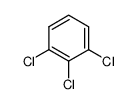1,2,3-trichlorobenzene

1,2,3-trichlorobenzene structure
|
Common Name | 1,2,3-trichlorobenzene | ||
|---|---|---|---|---|
| CAS Number | 87-61-6 | Molecular Weight | 181.44700 | |
| Density | 1,69 g/cm3 | Boiling Point | 218-219 °C(lit.) | |
| Molecular Formula | C6H3Cl3 | Melting Point | 51-53 °C(lit.) | |
| MSDS | Chinese USA | Flash Point | 260 °F | |
| Symbol |



GHS02, GHS06, GHS08 |
Signal Word | Danger | |
|
QSPR modeling of octanol/water partition coefficient for vitamins by optimal descriptors calculated with SMILES.
Eur. J. Med. Chem. 43 , 714-40, (2008) Simplified molecular input line entry system (SMILES) has been utilized in constructing quantitative structure-property relationships (QSPR) for octanol/water partition coefficient of vitamins and organic compounds of different classes by optimal descriptors.... |
|
|
Evaluation of injection methods for fast, high peak capacity separations with low thermal mass gas chromatography.
J. Chromatogr. A. 1392 , 82-90, (2015) Low thermal mass gas chromatography (LTM-GC) was evaluated for rapid, high peak capacity separations with three injection methods: liquid, headspace solid phase micro-extraction (HS-SPME), and direct vapor. An Agilent LTM equipped with a short microbore capil... |
|
|
Determination of chlorobenzenes in water samples by solid-phase disk extraction and gas chromatography-electron capture detection.
J. Chromatogr. Sci. 52(5) , 375-82, (2014) A simple, rapid, sensitive and high throughput method is described, based on solid-phase disk extraction (SPDE) and gas chromatography-electron capture detection, for the determination of chlorobenzens (CBs) in water samples. The proposed SPDE sample pretreat... |
|
|
Environmental contaminants activate human and polar bear (Ursus maritimus) pregnane X receptors (PXR, NR1I2) differently.
Toxicol. Appl. Pharmacol. 284(1) , 54-64, (2015) Many persistent organic pollutants (POPs) accumulate readily in polar bears because of their position as apex predators in Arctic food webs. The pregnane X receptor (PXR, formally NR1I2, here proposed to be named promiscuous xenobiotic receptor) is a xenobiot... |
|
|
Aniline-phenol recognition: from solution through supramolecular synthons to cocrystals.
IUCrJ 1 , 228-39, (2014) Aniline-phenol recognition is studied in the crystal engineering context in several 1:1 cocrystals that contain a closed cyclic hydrogen-bonded [⋯O-H⋯N-H⋯]2 tetramer supramolecular synthon (II). Twelve cocrystals of 3,4,5- and 2,3,4-trichlorophenol with one o... |